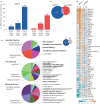Multi-species comparisons of snakes identify coordinated signalling networks underlying post-feeding intestinal regeneration
- PMID: 31288694
- PMCID: PMC6650723
- DOI: 10.1098/rspb.2019.0910
Multi-species comparisons of snakes identify coordinated signalling networks underlying post-feeding intestinal regeneration
Abstract
Several snake species that feed infrequently in nature have evolved the ability to massively upregulate intestinal form and function with each meal. While fasting, these snakes downregulate intestinal form and function, and upon feeding restore intestinal structure and function through major increases in cell growth and proliferation, metabolism and upregulation of digestive function. Previous studies have identified changes in gene expression that underlie this regenerative growth of the python intestine, but the unique features that differentiate this extreme regenerative growth from non-regenerative post-feeding responses exhibited by snakes that feed more frequently remain unclear. Here, we leveraged variation in regenerative capacity across three snake species-two distantly related lineages ( Crotalus and Python) that experience regenerative growth, and one ( Nerodia) that does not-to infer molecular mechanisms underlying intestinal regeneration using transcriptomic and proteomic approaches. Using a comparative approach, we identify a suite of growth, stress response and DNA damage response signalling pathways with inferred activity specifically in regenerating species, and propose a hypothesis model of interactivity between these pathways that may drive regenerative intestinal growth in snakes.
Keywords: NRF2; RNAseq; insulin signalling; proteomics; stress response; unfolded protein response.
Conflict of interest statement
We declare we have no competing interests.
Figures




References
-
- Andrew AL, Card DC, Ruggiero RP, Schield DR, Adams RH, Pollock DD, Secor SM, Castoe TA. 2015. Rapid changes in gene expression direct rapid shifts in intestinal form and function in the Burmese python after feeding. Physiol. Genomics. 47, 147–157. (10.1152/physiolgenomics.00131.2014) - DOI - PMC - PubMed
Publication types
MeSH terms
Substances
Associated data
Grants and funding
LinkOut - more resources
Full Text Sources

